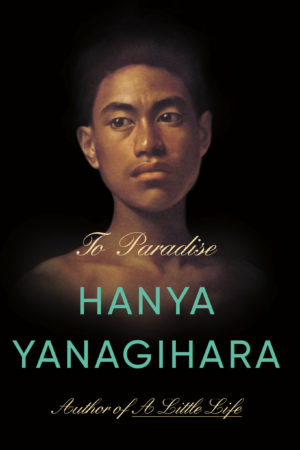To Paradise
by Hanya Yanagihara
reviewed by Hamilton Cain
In 2015 Hanya Yanagihara published A Little Life, which chronicled the troubled psyches and relationships among four friends in Manhattan. The novel was a kind of Rorschach test for critics and readers alike: many fans swooned over the cult hit, which was shortlisted for the Booker Prize and named a finalist for the National Book Award. A few contrarians shrugged it off as overwrought, but few could deny that a major talent blazed beneath its cloyingly operatic scenes.
To Paradise, Yanagihara’s dense, ambitious new novel, is a leap forward: she constructs a wildly speculative story that enthralls even as it challenges readers. With impeccable control, she examines the rot at the heart of the American experiment, reimagining the nation’s legacy at three different junctures in an alternative history.
The first section, “Washington Square,” set in 1893, depicts an America where the postbellum Northern Free States are governed by rigid hierarchies, the Southern “Colonies” preserve their racist institutions, and the West is an enchanted place of escape. In New York, same-sex marriages are accepted (and arranged) just like heterosexual unions, albeit constrained by considerations of wealth, class, and citizenship. As To Paradise opens, the elderly patriarch of the Bingham family meets with his three grown grandchildren in his elegant Greenwich Village townhouse to divvy up his fortune. The frail David receives the coveted prize of the townhouse, but there’s a catch: his grandfather would like him to exchange vows with an older suitor, Charles, to maintain the ruling class family’s power—a proposition David rejects once he meets a handsome, charismatic and impoverished music teacher. The language of “Washington Square” is rich and exacting, calling to mind the social novels of Henry James and Edith Wharton, and the lavish textures of Martin Scorsese’s 1993 film adaptation of The Age of Innocence. Cinematic and lyrical, “Washington Square” appeals to the eye as well as the ear.
The second section, “Lipo-Wao-Nahele,” set in 1993, is about another David—this one a young Hawaiian man living with his older partner Charles in AIDS-ravaged New York. Here Yanagihara captures the opprobrium visited upon victims of the epidemic, with strong echoes of Jonathan Demme’s Philadelphia (also released in 1993). David’s fraught past, and the lengths he goes to in order to hide his secrets, propel “Lipo-Wao-Nahele” forward. Here Yanagihara plays with Hawaiian legend and erasures large and small. As Yanagihara writes of David: “He wondered now if he was another one of those people in Charles’s life, someone whose appeal would not only be ruined by the complications of his history but who had indeed been chosen because he seemed to have no history at all.” There are familiar names in this episode—Bingham, Bishop, Griffith, David, Charles, Edward—but do they relate to the 1893 tale? Yanagihara, who has a few tricks up her sleeve, doesn’t tell us outright.
Flash forward to 2093. In “Zone Eight,” To Paradise’s longest section, the narrator Charlie—the granddaughter of an esteemed scientist—clings to sanity in a chaotic city. As she pieces together the puzzle of her husband’s disappearance, she relies on letters written by her deceased grandfather, a Hawaiian transplant, to find out the truth. “Zone Eight” leans heavily on current headlines as well as our vogue for dystopian fiction. It’s set against a backdrop of authoritarian rule: Manhattan is carved up into concentration camps, echoing the 1981 film Escape from New York. Yanagihara looks to apocalypse movies and literary classics alike, influences that she melds into an achievement all her own. “Zone Eight” is long, but, in this case, more is more.
Charlie looks back on the twenty-first century as a brutal, unsparing series of pandemics which has precipitated a breakdown of order. Her glimpse of Washington Square is chilling, as we recognize our own civilization beneath its red-brick trappings. Yanagihara thwarts reader expectations as she confronts climate-change and authoritarianism. Like other recent world-building tours de force, such as Anthony Doerr’s Cloud Cuckoo Land and Colson Whitehead’s The Underground Railroad, she comes at her story prismatically, shifting perspective and mood to expose enduring social ills. To Paradise’s fractured structure is itself a commentary on our morally disjointed moment. Yet the Washington Square townhouse brings together the book’s disparate strands. The first David Bingham’s musings, from 1893, mirror our own experience of To Paradise as a sort of literary time machine:
Later, David would have the sense that the house, already capacious, had cleaved new rooms, that new wings and spaces had magically revealed themselves to accommodate them, that the room he came to call his own (and still did) had been conjured out of need and not simply remade into what it was from what it had been, a little-used extra sitting room.
For all the darkness, Yanagihara offers glimmers of human connection as a kind of balm, the sign of a paradise regained. To Paradise expands on the promise of A Little Life with a layered narrative that’s more daring yet more restrained, executed with a dazzling technique that raises the novel above its peers.
Published on January 11, 2022

